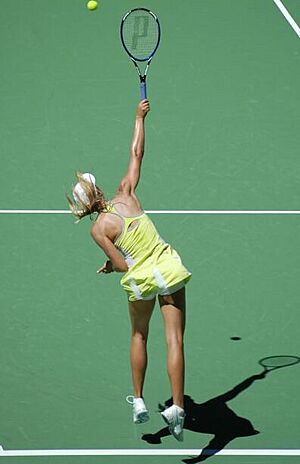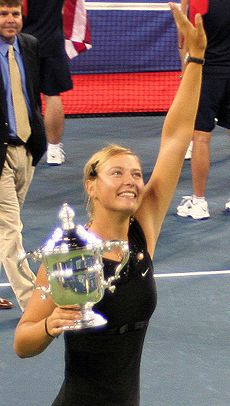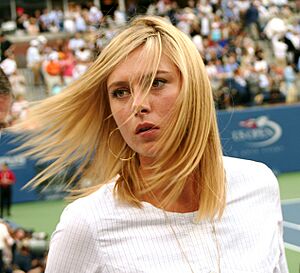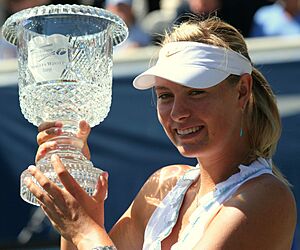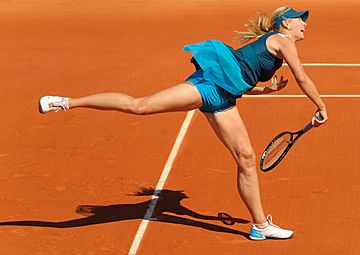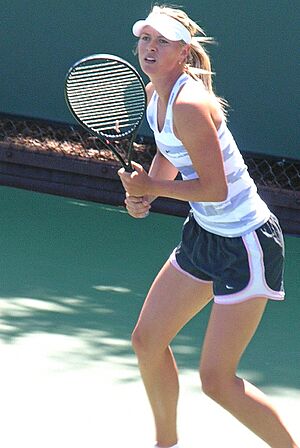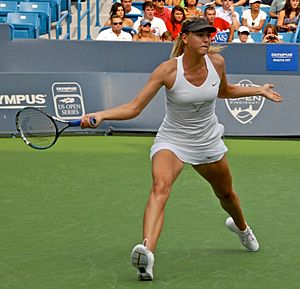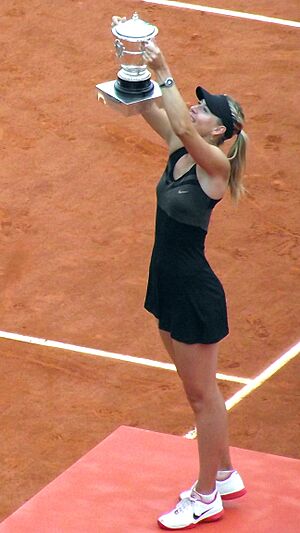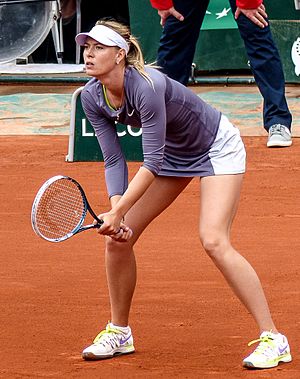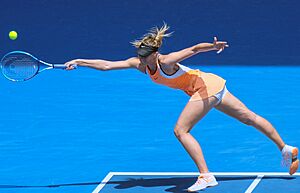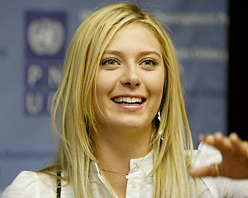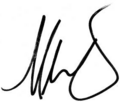Maria Sharapova facts for kids

Sharapova in 2024
|
|||||||||||
| Full name | Mariya Yuryevna Sharapova | ||||||||||
|---|---|---|---|---|---|---|---|---|---|---|---|
| Native name | Мария Шарапова | ||||||||||
| Country (sports) | |||||||||||
| Residence | Florida and California, USA | ||||||||||
| Born | 19 April 1987 Nyagan, Russian SFSR, Soviet Union |
||||||||||
| Turned pro | 19 April 2001 | ||||||||||
| Retired | 26 February 2020 | ||||||||||
| Plays | Right-handed (two-handed backhand) | ||||||||||
| Prize money | $38,777,962
|
||||||||||
| Singles | |||||||||||
| Career record | 645–171 (79.04%) (79.0%) | ||||||||||
| Career titles | 36 | ||||||||||
| Highest ranking | No. 1 (22 August 2005) | ||||||||||
| Grand Slam singles results | |||||||||||
| Australian Open | W (2008) | ||||||||||
| French Open | W (2012, 2014) | ||||||||||
| Wimbledon | W (2004) | ||||||||||
| US Open | W (2006) | ||||||||||
| Other tournaments | |||||||||||
| Tour Finals | W (2004) | ||||||||||
| Olympic Games | F (2012) | ||||||||||
| Doubles | |||||||||||
| Career record | 23–17 (57.5%) | ||||||||||
| Career titles | 3 | ||||||||||
| Highest ranking | No. 41 (14 June 2004) | ||||||||||
| Grand Slam doubles results | |||||||||||
| Australian Open | 2R (2003, 2004) | ||||||||||
| US Open | 2R (2003) | ||||||||||
| Mixed doubles | |||||||||||
| Career record | 2–1 (66.7%) | ||||||||||
| Career titles | 0 | ||||||||||
| Grand Slam mixed doubles results | |||||||||||
| US Open | QF (2004) | ||||||||||
| Team competitions | |||||||||||
| Fed Cup | W (2008) | ||||||||||
| Signature | |||||||||||
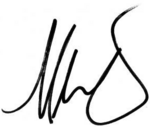 |
|||||||||||
|
Medal record
|
|||||||||||
Maria Sharapova (born April 19, 1987) is a famous Russian former professional tennis player. She was ranked as the world No. 1 in women's singles by the Women's Tennis Association (WTA) for 21 weeks. Maria won 36 singles titles, including five major championships called Grand Slams. She also won the 2004 WTA Tour Championships. Maria is one of only ten women to achieve the career Grand Slam in singles, meaning she won all four major tournaments at least once.
Maria became a tennis star at a young age. She won the 2004 Wimbledon Championships when she was just 17, beating the champion Serena Williams. She then won the 2004 Tour Finals and became the world No. 1 in August 2005 at 18. She was the first Russian woman to reach the top singles ranking. She continued to succeed, winning the 2006 US Open and 2008 Australian Open. However, she also faced injuries.
After working hard to improve her game on clay courts, Maria won the 2012 French Open. This completed her career Grand Slam. She also returned to the No. 1 spot and won an Olympic silver medal at the 2012 London Olympics. She won her fifth major title at the 2014 French Open.
In 2016, Maria faced a challenge when a substance she had been taking for health reasons became banned in tennis. She was suspended from playing for a period. The suspension was later reduced, and she returned to the WTA Tour in April 2017. Maria retired from tennis in 2020.
Outside of tennis, Maria has been involved in modeling and advertisements for big brands like Nike and Canon. She has also been a UNDP Goodwill Ambassador since 2007, helping with projects related to the Chernobyl Recovery and Development Programme. Forbes magazine named her the highest-paid female athlete for 11 years in a row. In 2018, she started a program to help women who are starting their own businesses.
Maria's Early Life and Tennis Start
Growing Up in Russia
Maria Yuryevna Sharapova was born on April 19, 1987, in Nyagan, Russia. Her parents, Yuri and Yelena, were from Gomel, Belarus. They moved away from their hometown before Maria was born because they were worried about the effects of the 1986 Chernobyl nuclear accident.
In 1990, when Maria was three, her family moved to Sochi, Russia. Her father, Yuri, became friends with Aleksandr Kafelnikov. Aleksandr's son, Yevgeny, later became a famous tennis player. Aleksandr gave Maria her first tennis racquet in 1991 when she was four. She started practicing regularly with her father at a local park. Maria took her first tennis lessons with a Russian coach named Yuri Yutkin. He was very impressed by her "exceptional hand-eye coordination" right away.
Moving to the United States for Training
In 1993, at age six, Maria went to a tennis clinic in Moscow. There, famous tennis player Martina Navratilova saw her play. Martina suggested that Maria get professional training with Nick Bollettieri at the IMG Academy in Bradenton, Florida.
Maria's family didn't have much money. Her father, Yuri, borrowed money so he and Maria could travel to the United States in 1994. Neither of them spoke English. Maria's mother couldn't join them for two years because of visa rules. When they arrived in Florida, they only had $700. Maria's father worked many low-paying jobs to pay for her lessons. This continued until she was old enough to join the academy.
In 1995, IMG signed Maria. They agreed to pay the $35,000 yearly tuition fee for her to stay at the academy. This allowed her to finally enroll at age 9.
Maria's Tennis Journey
Junior and Early Professional Career
Maria first gained attention in November 2000. She won the Eddie Herr International Junior Tennis Championships in the girls' 16 division at just 13 years old. She received a special "Rising Star Award" for her great potential.
Maria made her professional debut on her 14th birthday, April 19, 2001. She played her first WTA tournament in 2002 at the Pacific Life Open. She won one match before losing to Monica Seles. Because there were rules about how many professional events she could play, Maria focused on junior tournaments. She reached the finals of the girls' singles events at the Australian Open and Wimbledon in 2002. At 14 years and 9 months, she was the youngest girl ever to reach the Australian Open junior final.
Maria reached No. 6 in the junior world singles ranking in October 2002. Overall, she won three junior singles tournaments and was runner-up in five. Her junior record was 47 wins and 9 losses.
First Professional Titles in 2003
In 2003, Maria played a full season and quickly moved into the top 50 players by the end of the year. She played in the Australian Open and French Open for the first time but didn't win a match in either.
Then, at Wimbledon, she was given a special entry as a wildcard. She beat the 11th seed Jelena Dokić, which was her first win against a top-20 player. She reached the fourth round before losing to Svetlana Kuznetsova. By September, Maria had won her first WTA title at the Japan Open Tennis Championships. She won her second title at the Bell Challenge in Quebec City. To celebrate her first full professional season, she was named the WTA Newcomer of the Year.
Wimbledon Victory and Fame in 2004
Maria was defeated in the third round of the Australian Open by Anastasia Myskina. She later reached the semifinals at the Cellular South Cup.
During the spring clay-court season, Maria entered the top 20 in the WTA rankings. This was because she reached the third round of two big tournaments, the Qatar Telecom German Open and the Internazionali BNL d'Italia. At the latter event, she beat a top-10 player for the first time, Elena Dementieva. Later, she reached the quarterfinals of a Grand Slam for the first time at the French Open.
Maria won her third career title at the DFS Classic, a tournament before Wimbledon. At Wimbledon, she was seeded 13th and was 17 years old. She reached her first Grand Slam semifinal by beating Ai Sugiyama. Then, she defeated former champion Lindsay Davenport. In the final, Maria surprised everyone by beating the top seed and defending champion Serena Williams. She won her first Grand Slam singles title and became the third-youngest woman to win Wimbledon. This victory was called "the most stunning upset in memory" by the media. Maria entered the top 10 rankings for the first time after this win.
After her Wimbledon win, Maria became very popular. She won two more titles in Asia that fall. In October, she reached the final of a big tournament, the Zurich Open, where she lost to Alicia Molik. She then made her debut at the year-end WTA Tour Championships. She won two of her three group matches and then beat Myskina in the semifinals. In the final, she defeated an injured Serena Williams.
Becoming World No. 1 in 2005
Maria started 2005 at the Australian Open. She reached her second Grand Slam semifinal, where she lost to Serena Williams. In February, Maria won two tournaments in a row, the Toray Pan Pacific Open and the Qatar Total Open. This helped her reach number 3 in the world rankings.
She reached the semifinals of a clay-court tournament for the first time at the Italian Open. If she had won that tournament, she would have become world No. 1. Maria then reached the quarterfinals of the French Open for the second year in a row. On grass, she won her third title of the year by defending her title at the DFS Classic. As the defending champion at Wimbledon, Maria reached the semifinals without losing a set. However, she was then beaten by Venus Williams.
Maria became the first Russian woman to be ranked world No. 1 on August 22, 2005. Her time at No. 1 lasted only one week. She regained the No. 1 ranking on September 12, 2005, and held it for six weeks.
US Open Champion in 2006
Maria started 2006 by losing in the semifinals of the Australian Open. She won her first title in nine months at a big tournament in Indian Wells. She reached the final in Miami but lost.
At the French Open, she was eliminated in the fourth round. At Wimbledon, she lost in the semifinals to the eventual champion.
Maria won her second title of the year at the Acura Classic. As the third seed at the US Open, Maria beat the top seed in the semifinals. She then defeated Justine Henin to win her second Grand Slam singles title.
That autumn, Maria won two titles in a row. She finished the year ranked world No. 2, her best year-end ranking.
Injuries and Comebacks (2007-2015)
Maria was the top seed at the Australian Open. She reached the final for the first time but lost to Serena Williams. After this, Maria became world No. 1 again for seven weeks. A shoulder injury forced her to miss most of the clay-court season. She reached the semifinals of the French Open for the first time. Maria won her only championship of the year at the Acura Classic. At the US Open, she lost in the third round. She finished the year in the top 5.
Maria was seeded fifth at the Australian Open and was not expected to win. However, she defeated the world No. 1 Henin in the quarterfinals. She then won her third Grand Slam title by beating Ana Ivanovic in the final, without losing a single set in the tournament. Maria won two more tournaments after the Australian Open. In May, she became world No. 1 again. At Wimbledon, she lost in the second round. Maria had to withdraw from all tournaments for the rest of 2008 due to a shoulder injury. She had surgery in October.
Maria did not play in the Australian Open as she recovered from surgery. She returned to singles tennis in May 2009 and reached the quarterfinals of the French Open. At Wimbledon, she lost in the second round. Maria had good results in the summer, reaching a final at the Rogers Cup. At the US Open, she lost in the third round. She won her first title of the year in Tokyo. She finished 2009 ranked world No. 14.
Maria started 2010 by losing in the first round of the Australian Open. She then won a smaller American event, the Cellular South Cup. She won her first title on red clay at the Internationaux de Strasbourg. At Wimbledon, she lost in the fourth round to Serena Williams. Maria reached two finals in the summer, losing to Victoria Azarenka and Kim Clijsters. She finished 2010 at number 18 in the world.
In 2011, Maria reached the semifinals of the Indian Wells Open and the final of Key Biscayne. With this, she returned to the top 10 rankings. She won the Italian Open, her biggest clay-court victory. At the 2011 French Open, she reached the semifinals. At the Wimbledon Championships, Maria reached the final but lost. She won the Cincinnati Open, her second title of the year. She finished 2011 as No. 4 in the world.
Maria reached the final of the 2012 Australian Open but lost to Victoria Azarenka. She won her first title of 2012 at the Porsche Grand Prix in Stuttgart. She successfully defended her title at the Italian Open.
Maria was seeded second at the French Open. She won the tournament, earning her fourth Grand Slam title and her first French Open title. This made her the tenth woman to complete a Career Grand Slam. She also became the first Russian female athlete to carry the flag at the opening ceremony for the 2012 Summer Olympics in London. At the Olympics, she won a silver medal in singles, losing to Serena Williams in the final. At the US Open, she reached the semifinals. She finished 2012 as world No. 2.
Maria started 2013 at the Australian Open. She won her first two matches without losing a single game. She reached the semifinals but lost to Li Na. She won the Indian Wells tournament, her 28th career title. She also won the Stuttgart Open for the second time. She reached the final of the Madrid Open and the French Open, losing both to Serena Williams. Maria withdrew from the US Open due to a shoulder injury, ending her season early.
Maria returned in 2014. She reached the semifinals of the Brisbane International and the fourth round of the Australian Open. She won the Stuttgart Open for the third time. In May, Maria won the Madrid Open, her second title of the year.
Maria was seeded seventh at the 2014 French Open. She reached her third consecutive French Open final and defeated Simona Halep to win her second French Open title and fifth overall Major title. This was a very exciting match. At Wimbledon, she reached the fourth round. She won the China Open, which helped her ranking rise to No. 2 in the world. She finished 2014 as world No. 2.
Maria started 2015 by winning the Brisbane International. This meant she had won at least one title every year for 13 years. She reached her fourth Australian Open final but lost to Serena Williams. She won her third Rome title. At Wimbledon, she reached the semifinals. She withdrew from the US Open due to a knee injury. Maria finished 2015 as the world No. 4.
Later Career and Retirement (2016-2020)
Maria began 2016 at the Australian Open. She reached the quarterfinals, where she lost to Serena Williams. After this tournament, Maria faced a challenge. A substance she had been taking for health reasons became banned in tennis starting January 1, 2016. Maria explained that she had not known about the new rule. She was suspended from playing tennis for two years. In October 2016, her suspension was reduced to 15 months. The sports court found that she had made "no significant fault" and had taken the substance based on a doctor's advice, believing it was allowed.
Maria returned to the WTA Tour in April 2017. She played in several tournaments with special invitations. She reached the semifinals of the Porsche Grand Prix. At the US Open, she won her first match against world No. 2 Simona Halep. She reached the fourth round. Maria won her first WTA title since 2015 at the Tianjin Open in China. This win helped her ranking climb back into the top 60.
Maria started 2018 at the Shenzhen Open, reaching the semifinals. She played at the Australian Open for the first time since her suspension. She reached the quarterfinals of the 2018 French Open. This was her first Grand Slam quarterfinal since 2016. She finished 2018 ranked 29.
In 2019, Maria played her 800th career singles match at the Shenzhen Open. She reached the fourth round of the Australian Open. She continued to face injuries, which limited her play. She lost in the first round of Wimbledon and the US Open. She ended 2019 ranked No. 131, her lowest year-end ranking since 2002.
Maria's last professional match was at the 2020 Australian Open, where she lost in the first round. On February 26, 2020, Maria Sharapova announced her retirement from tennis. She wrote in an essay that she was saying goodbye to tennis and encouraged others to trust themselves even when facing doubts and failures.
Maria's Playing Style
Maria was known for her powerful game. She hit the ball with great speed and depth. Her backhand was considered one of the best in tennis. She could hit winners from anywhere on the court with her backhand. Her forehand was also strong. Later in her career, she added a drop shot and a sliced backhand to her game.
Maria was very mentally tough and competitive. Many experts said she was one of the best competitors in the history of tennis. She was known for her loud "grunting" during matches.
Serve and Net Play
Early in her career, Maria's serve was very powerful. However, shoulder problems later affected her serve, sometimes leading to many double faults. After her shoulder surgery, she worked to improve her serve. She even hit a serve at 121 mph (195 km/h), her fastest ever.
Maria often used powerful "swinging" volleys when she came to the net. Later in her career, she improved her net play and could hit delicate volleys more often.
Favorite Surfaces
Maria's favorite surfaces early in her career were fast hard courts, grass, and carpet courts. She found clay courts more challenging at first. She once joked that she felt like a "cow on ice" on clay. But she worked hard and improved a lot on clay. She won two Roland-Garros titles on clay. By 2014, she had one of the best winning percentages on clay among active players.
Coaches Who Helped Maria
Maria had several coaches during her career. Besides her father Yuri, some of her coaches included Michael Joyce, Jimmy Connors, Sven Groeneveld, Thomas Högstedt, and Riccardo Piatti.
Maria's Life Outside Tennis
Family and Home
Maria has lived in the United States since she was seven. She has homes in Florida and California. In 2011, she was engaged to basketball player Sasha Vujačić, but they ended their engagement in 2012. From 2012 to 2015, she dated tennis player Grigor Dimitrov.
Since 2018, Maria has been in a relationship with English businessman Alexander Gilkes. They got engaged in December 2020. On July 1, 2022, Maria gave birth to their son.
Public Recognition
From 2005 to 2011, Forbes magazine listed Maria as one of the top 100 most powerful celebrities. She was also named the highest-paid female athlete in the world for many years. People magazine named her one of the 50 most beautiful celebrities.
Maria has recently started playing pickleball. In 2024, she played a doubles match with John McEnroe.
Helping Others
The Maria Sharapova Foundation helps children around the world. Maria has given money to projects related to the Chernobyl disaster. She also started a scholarship program for students from areas affected by Chernobyl. In 2005, she donated money to help those affected by the Beslan school hostage crisis. In 2007, she became a UNDP Goodwill Ambassador and donated money to Chernobyl-recovery projects. Maria helped promote the 2014 Winter Olympics in Sochi, Russia, and was the first person to carry the torch in the opening ceremony.
Her Book
Maria's autobiography, Unstoppable. My Life So Far, was published on September 12, 2017.
Maria's Endorsements and Businesses
Maria's success and popularity helped her get many endorsement deals. She earned a lot of money from these deals, even more than her tournament winnings. She worked with big brands like Motorola, Land Rover, Canon, Tag Heuer, and Tiffany. She also starred in a famous Nike advertisement called "Pretty".
In 2010, Maria launched her own tennis clothing line with Nike, called the Nike Maria Sharapova Collection. She helped design the dresses she wore at major tournaments. She also designed shoes and handbags for Cole Haan.
Maria used Prince racquets for many years. In 2011, she switched to Head racquets and used them until she retired. In 2013, she became a brand ambassador for Porsche.
In 2012, Maria launched her own candy brand called Sugarpova. She has also invested in other businesses, including a sunscreen brand called Supergoop and a wellness brand called Therabody. In April 2022, Maria joined the Board of Directors for the fashion brand Moncler.
Maria in Film and TV
Maria has appeared in some TV shows and movies:
- Chelsea (2016) - Herself
- Maria Sharapova: The Point (2017) - Herself (a documentary about her)
- Billions (2018, 2020) - Herself
- Ocean's 8 (2018) - Herself (a small appearance)
- The Morning Show (2019) - Herself
- Shark Tank (2020) - Guest Shark
Images for kids
See also
 In Spanish: María Sharápova para niños
In Spanish: María Sharápova para niños



